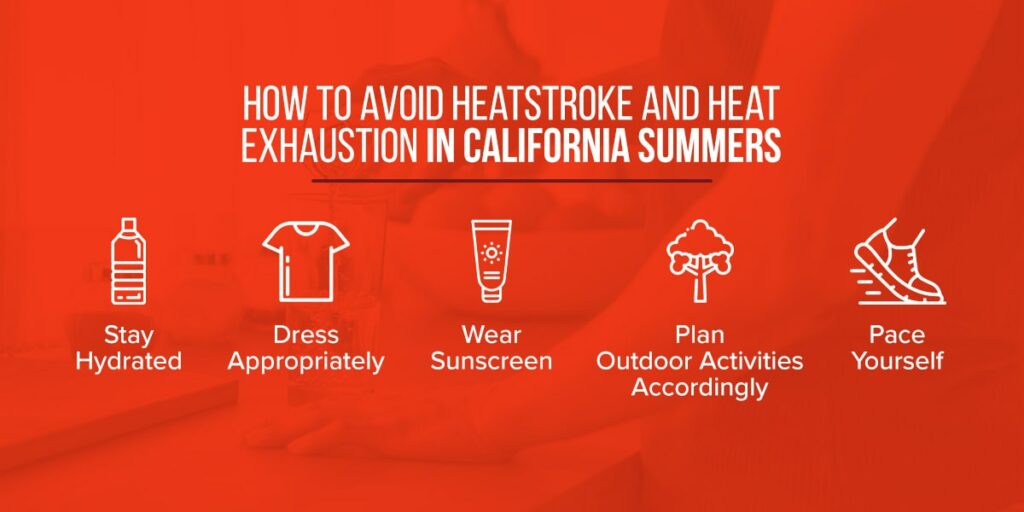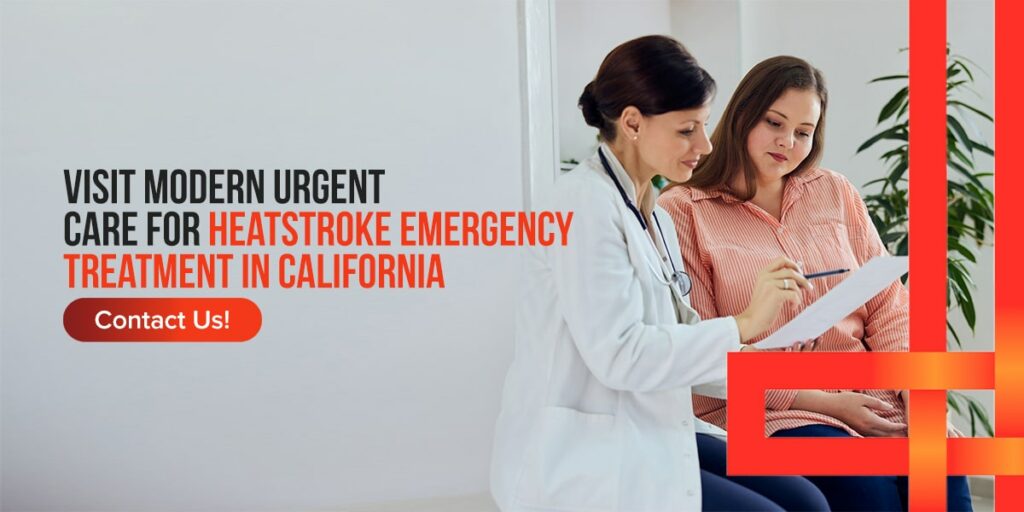The number of heat-induced illnesses in California fluctuates from year to year. However, they increased significantly after a record-breaking heat wave in 2006.
That year, about 16,000 more emergency room visits occurred from July to August. Additionally, multiple cities in California broke records for the highest number of consecutive days with temperatures over 100 degrees Fahrenheit. With soaring summer temperatures and heat illnesses an ongoing concern in this state, proper precautions are essential.
Heat illness can range anywhere from mild cramps to life-threatening heatstroke. Appropriate safety measures can help you avoid these symptoms while exercising or working outdoors. If you’re wondering how to prevent heatstroke and heat exhaustion, continue reading for some essential tips.
Heat Exhaustion vs. Heatstroke
Heat exhaustion occurs from excess sweating, resulting in low water and salt levels. It is the body’s response to extreme heat and dehydration after prolonged exposure to high temperatures and inadequate fluid intake. Older adults, people with high blood pressure and those who work or exercise in hot environments are most likely to experience heat exhaustion.
Heat exhaustion is a milder heat-related illness, but it can progress into a more severe issue called heatstroke. Heatstroke is a medical emergency, as your body cannot control its internal temperature. Either condition can take anywhere from a few minutes to several days to develop.
Heat Exhaustion Symptoms
The following symptoms can indicate heat exhaustion:
- Excessive sweating
- Pale and clammy skin
- Weakness or tiredness
- Muscle cramps
- Headaches
- Nausea or vomiting
- Dizziness and confusion
- Shortness of breath
- Rapid pulse
How to Respond to Heat Exhaustion or Heatstroke
Here are some steps you can take if someone you know is exhibiting signs of heat exhaustion:
- Move them to a cooler environment, like a shaded area or well-air-conditioned room.
- Loosen their clothing.
- Have them sit in a cool bath or apply a cool, wet cloth or sponge to their skin.
- Give them sips of water.
- Continue cooling efforts and monitor their body temperature until it drops to 101 to 102 degrees Fahrenheit.
If the person can cool down, heat exhaustion isn’t an emergency. However, the following signs can indicate that heat exhaustion is progressing into heatstroke. A person needs urgent medical attention if:
- They vomit more than once.
- Their symptoms worsen or persist for longer than an hour.
- Their body temperature is above 103 degrees Fahrenheit.
- They have stopped sweating but still feel hot.
- They lose consciousness.
- They experience a seizure.


How to Avoid Heatstroke and Heat Exhaustion in California Summers
Whether hiking through the wilderness, doing yardwork or going for a long run, numerous outdoor activities can expose you to the scorching sun, increasing your risk of heat exhaustion. Fortunately, there are various ways to prepare your body for extended sun exposure and prevent heat-related illness.
1. Stay Hydrated
Proper hydration helps control sweating so your body can maintain a consistent temperature. Sweating removes minerals and salt your body needs.
Drinking plenty of water throughout the day is essential, especially during outdoor excursions or other activities with prolonged heat exposure. Checking your urine color can help determine if you’ve sufficiently hydrated. A dark yellow color usually indicates you aren’t getting enough fluids.
Heat illness can also result from salt depletion from sweating, so you may also want to replenish your salts and electrolytes with a sports drink during high heat and humidity. Avoid alcohol and drinks with caffeine, such as coffee, soda and tea. These beverages can cause more fluid loss and aggravate heat exhaustion. Pack some snacks before embarking on your activity, too.
2. Dress Appropriately
Wear lightweight, loose-fitting clothing to prepare for a hike, run or other outdoor activity where you’ll experience extreme heat. Excess or tight-fitting clothes can prevent your body from cooling itself properly. Choose wide-brimmed hats, light and flowy tanks and comfortably fitting shorts to give your skin room to breathe.
It’s also best to choose light-colored garments. Dark-colored clothing absorbs sunlight and heat, which can increase internal temperatures and cause heat and discomfort.
3. Wear Sunscreen
Your skin plays a vital role in regulating your body’s temperature. Experiencing a skin injury — such as a cut, scrape or sunburn — can compromise your body’s temperature control abilities.
Since sunburn can hinder your body’s ability to cool itself, it’s critical to wear ample sunscreen if you’re in direct sunlight. Before heading outdoors, generously apply a broad-spectrum sunscreen with a sun protection factor of 15 or higher. Following the package’s recommendations, reapply it every two hours while you’re in the sun.
Reapply it on exposed skin more often when sweating excessively or swimming. Wearing sunglasses and a wide-brimmed hat can also help protect your skin from UV exposure.
4. Plan Outdoor Activities Accordingly
Carefully scheduling outdoor activities can help you avoid excess sun exposure, heat exhaustion and heat stroke. The city of Ventura recommends staying indoors and avoiding strenuous activity during the hottest part of the day, from noon to 4 p.m. Monitor local weather and news to plan for hotter days.
Try to do hikes, physical labor, exercise and other outdoor excursions during the cooler morning and evening hours, if possible. If you must go outdoors during hours of extreme heat, take plenty of breaks to drink fluids and rest in a cool, shady spot.
5. Pace Yourself
Start slowly and gradually pick up the pace, especially if you don’t typically work or exercise in hot weather. Try to limit your time outdoors until your body gets used to it. People not accustomed to doing physical activity in the heat are more vulnerable to heat-related illnesses. Adjusting to hot weather can take several weeks.
Take frequent, consistent breaks while you’re out in the heat. If a particular activity increases your heart rate or complicates breathing, stop immediately. Get to a cool or shaded area, rest, drink fluids and allow your body to cool down. You should also take a break if you feel weak, dizzy, lightheaded or faint.


Visit Modern Urgent Care for Treatment of Heat Exhaustion Symptoms in California
With proper planning and precautions, you can protect yourself and others from heat-related illnesses. However, if you or a loved one experiences symptoms of heat exhaustion or heatstroke, immediate medical service is a must.
When you need medical attention for heat illness in the Central California Valley, our team at Modern Urgent Care can provide the care you need right away. You can schedule an appointment with us up to 20 minutes in advance.
As a value-based health care provider with locations in Stockton, Manteca and Ceres, we can help you avoid the long wait times and crowded waiting rooms that often accompany traditional health care facilities. Call 209-537-4700 or contact us online to book an appointment today!

